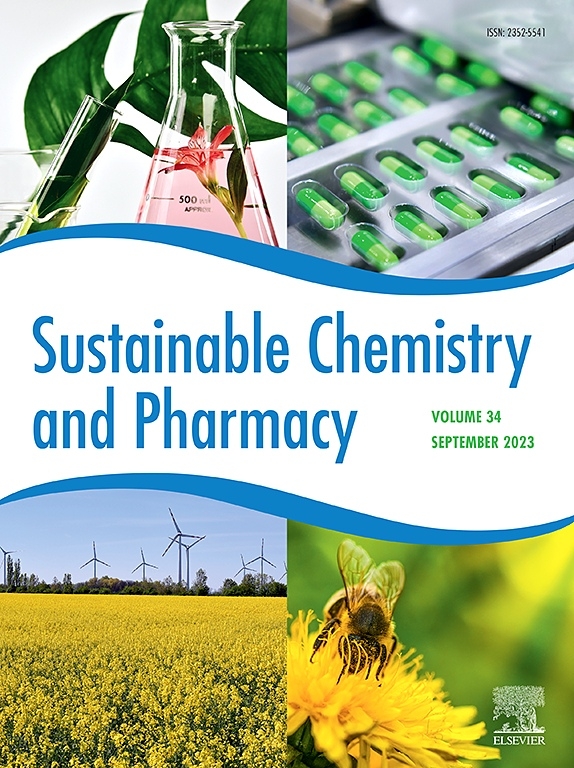Green synthesis of lignocellulose/silica hybrid materials from rice husk and bagasse and their adsorption properties
IF 5.5
2区 化学
Q2 CHEMISTRY, MULTIDISCIPLINARY
引用次数: 0
Abstract
The mesoporous lignocellulose/silica hybrids from rice husk and bagasse were prepared using the sol-gel method. The surface area and pore volume of these mesoporous lignocellulose/silica hybrids were increased compared to the raw rice husk and bagasse. These lignocellulose/silica hybrid materials can potentially be used for the removal of Congo red dye from aqueous solutions. Based on the experimental observation of consistently high adsorption over a wide pH range, the predominant adsorption mechanism for Congo red on these mesoporous lignocellulose/silica hybrid adsorbents is likely a combination of physical entrapment, strong hydrophobic interactions and H-bonding. The results of the adsorption kinetics of Congo red showed that the pseudo-second order kinetic equation can well explain the kinetic behavior of the adsorption of Congo red. The equilibrium adsorption isotherms of Congo red on the lignocellulose/silica hybrids could be described by the Langmuir model. The lignocellulose/silica hybrid prepared from bagasse showed higher adsorption capacity (61.50 mg/g) than the lignocellulose/silica hybrid prepared from rice husk (58.82 mg/g). The thermodynamic analysis showed that the adsorption of Congo red on the adsorbent is spontaneous and endothermic. Furthermore, these adsorbents exhibit good recyclability and stability.
稻壳和甘蔗渣绿色合成木质纤维素/二氧化硅杂化材料及其吸附性能
以稻壳和甘蔗渣为原料,采用溶胶-凝胶法制备了介孔木质纤维素/二氧化硅杂交种。与原稻壳和甘蔗渣相比,这些介孔木质纤维素/二氧化硅杂交种的比表面积和孔体积都有所增加。这些木质纤维素/二氧化硅杂化材料可用于从水溶液中去除刚果红染料。根据实验观察,在较宽的pH范围内,刚果红在这些介孔木质纤维素/二氧化硅杂化吸附剂上的主要吸附机制可能是物理夹持、强疏水相互作用和h键的结合。刚果红的吸附动力学结果表明,拟二级动力学方程可以很好地解释刚果红的吸附动力学行为。刚果红在木质纤维素/二氧化硅杂合体上的平衡吸附等温线可以用Langmuir模型来描述。以甘蔗渣为原料制备的木质纤维素/二氧化硅复合材料的吸附量为61.50 mg/g,高于以稻壳为原料制备的木质纤维素/二氧化硅复合材料的吸附量(58.82 mg/g)。热力学分析表明,刚果红在吸附剂上的吸附是自发的、吸热的。此外,这些吸附剂具有良好的可回收性和稳定性。
本文章由计算机程序翻译,如有差异,请以英文原文为准。
求助全文
约1分钟内获得全文
求助全文
来源期刊

Sustainable Chemistry and Pharmacy
Environmental Science-Pollution
CiteScore
8.20
自引率
6.70%
发文量
274
审稿时长
37 days
期刊介绍:
Sustainable Chemistry and Pharmacy publishes research that is related to chemistry, pharmacy and sustainability science in a forward oriented manner. It provides a unique forum for the publication of innovative research on the intersection and overlap of chemistry and pharmacy on the one hand and sustainability on the other hand. This includes contributions related to increasing sustainability of chemistry and pharmaceutical science and industries itself as well as their products in relation to the contribution of these to sustainability itself. As an interdisciplinary and transdisciplinary journal it addresses all sustainability related issues along the life cycle of chemical and pharmaceutical products form resource related topics until the end of life of products. This includes not only natural science based approaches and issues but also from humanities, social science and economics as far as they are dealing with sustainability related to chemistry and pharmacy. Sustainable Chemistry and Pharmacy aims at bridging between disciplines as well as developing and developed countries.
 求助内容:
求助内容: 应助结果提醒方式:
应助结果提醒方式:


